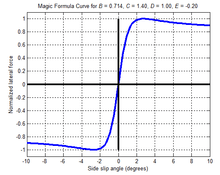Hans B. Pacejka
Hans Bastiaan Pacejka (born 1934) is an expert in vehicle system dynamics and particularly in tire dynamics, fields in which his works are now standard references.[1][2] He is Professor emeritus at Delft University of Technology in Delft, Netherlands.[3]
The Pacejka "Magic Formula" tire models

Pacejka has developed a series of tire design models over the last 20 years. They were named the 'magic formula' because there is no particular physical basis for the structure of the equations chosen, but they fit a wide variety of tire constructions and operating conditions. Each tire is characterized by 10-20 coefficients for each important force that it can produce at the contact patch, typically lateral and longitudinal force, and self-aligning torque, as a best fit between experimental data and the model. These coefficients are then used to generate equations showing how much force is generated for a given vertical load on the tire, camber angle and slip angle.[4]
The Pacejka tire models are widely used in professional vehicle dynamics simulations, and racing car games, as they are reasonably accurate, easy to program, and solve quickly.[5] A problem with Pacejka's model is that when implemented into computer code, it doesn't work for low speeds (from around the pit-entry speed), because a velocity term in the denominator makes the formula diverge.[6] An alternative to Pacejka tire models are brush tire models, which can be analytically derived, although empirical curve fitting is still required for good correlation,[7][8] and they tend to be less accurate than the MF models.[9]
The general form of the magic formula is: where b, c, d and e represent fitting constants and R is a force or moment resulting from a slip parameter k.
See also
Bibliography
- Pacejka, H. B., The wheel shimmy phenomenom: A theoretical and experimental investigation with particular reference to the nonlinear problem (Analysis of shimmy in pneumatic tires due to lateral flexibility for stationary and nonstationary conditions), Ph.D. Thesis, Delft University of Technology, Delft, 1966.
- Bakker, E. ; Nyborg, L. ; Hans B. Pacejka Tyre modelling for use in vehicle dynamics studies 1987 Jan. Society of Automotive Engineers, Warrendale, PA.
- PWA Zegelaar, HB Pacejka The in-plane dynamics of tires on uneven roads Vehicle System Dynamics, 1996 - ocp.tudelft.nl
- Pacejka, H. B. Tire and Vehicle Dynamics, Butterworth-Heinemann, Oxford, 2002.
References
- ↑ Ruud van Gaal (December 23, 2010). "Pacejka's Magic Formula". Racer. Retrieved 2011-03-19.
- ↑ Cossalter, Vittore (2006). Motorcycle Dynamics (2nd ed.). Lulu.com. p. 39. ISBN 978-1-4303-0861-4.
- ↑ Pacejka, Hans B. (2006). Tyre and vehicle dynamics (2nd ed.). SAE International. pp. back cover. ISBN 978-0-7680-1702-1.
- ↑ Brian Beckman (2001). "The Physics of Racing, Part 21: The Magic Formula: Longitudinal Version". Retrieved 2011-03-26.
- ↑ http://www.tut.fi/plastics/tyreschool/moduulit/moduuli_10/hypertext/index.html MF is "easy to handle, accurate, low effort"
- ↑ Beckman, Brian (2007) Brian Beckman: The Physics in Games - Real-Time Simulation Explained, at channel9.msdn.com, Jun 08, 2007, min. 29:53-33:45 quotation:
So, there's a problem with this Pacejka formula. [...] Our elephant in the way, is called divergence. Divergence is divide by zero. And there are variations on the theme of divide by zero. [...] Looking at both this angular formulas, the slip angle [...], if the velocity goes to zero, the angle goes to zero [...] So you actually get a divide by zero when you just try to do a computation of the Pacejka formula. It now says that the force on the tire is infinite. Remember I told some of this games when you start to go slow the car becomes uncontrollable? You're getting divergence in the Pacejka formula. [...] As you're starting to slow down the car, you're getting a purely artificial increase in the grip forces, the car becomes harder to control, perversely harder to control, incorrectly harder to control. Not because it's actually harder to control, but because the simulation, the computation, [...] they're going out of control. [...] The definition of the slip angle now becomes strictly undefined, when the velocity goes to zero [...] so you have to patch the formulas. The point is you can't blindly use the formulas. You can't blindly use the longitudinal slip formula either, because if you rewrite it correctly you'll find there is velocity in the denominator. [...] So what you'll see in games, is that the feeling of the car will change, that's because the physics simulator is changing formulas. And there'll be a nasty region of speeds, usually just about the speed when you're entering the pits, when it'll change, it'll flick her back and forth between using the real physics simulatr, which is starting to diverge, and the simplyfied formulas which are not accurate, they're more like arcade, and so the car just become really unpleasant to drive, at some little speed. And I've been able playing various games, and I've been able to find that spot where I can tell by driving it that the simulator is changing from real physics to faked physics.
- ↑ Jacob Svendenius, Björn Wittenmark (2003) [www.nt.ntnu.no/users/skoge/prost/proceedings/ecc03/pdfs/317.pdf Brush Tire Model with increased Flexibility], In European Control Conference, September 2003.
- ↑ Modelling of tyres
- ↑ http://www.tut.fi/plastics/tyreschool/moduulit/moduuli_10/hypertext/index.html "These models are not expected to give a very accurate correspondence with measurement but should predict the qualitative trends."